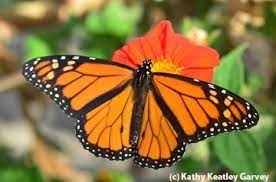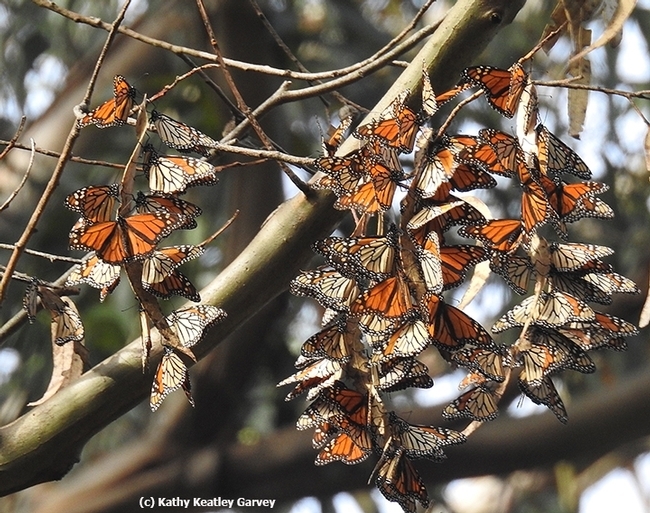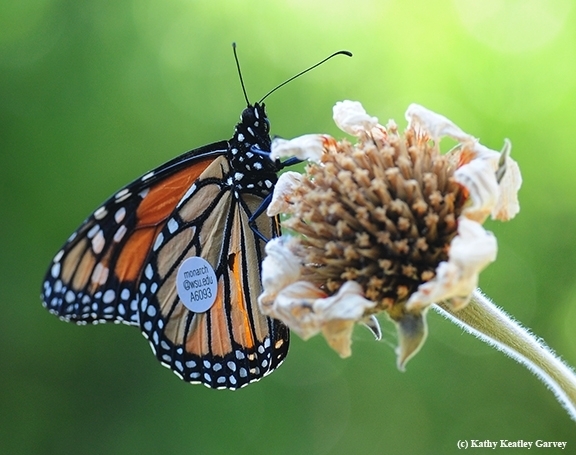
Entomologist and monarch scientist David James of Washington State University posted this yesterday on his Facebook page, Monarch Butterflies in the Pacific Northwest:
"Insect populations are well known for large annual fluctuations in size. However, rarely do these fluctuations occur on the scale currently being seen in western monarchs. From less than 2,000 monarchs counted in 2020, we currently have more than an estimated 200,000 at the overwintering sites! A 100-fold increase! This is staggering! However, it is less of a surprise to me than many others. In March 2021, I published a commentary paper titled Western North American Monarchs: Spiraling into Oblivion or Adapting to a Changing Environment? (Animal Migration journal). I suggested the latter was the case and stated: ‘the adaptability of the monarch butterfly will allow it to persist in a changed environment'. I based this on more than 40 years study of monarch populations, particularly research I did, published in peer-reviewed journals, that showed monarchs in Australia (they arrived in 1870 by island-hopping across the Pacific) had adapted physiologically to Australian conditions. I think we are seeing this monarch ‘power' now. They are trying different things in terms of life strategies and inevitably there will be failures and successes. This is how insects adapt and evolve. We will see more ups and downs in the future, but I have seen how adaptive and resilient the monarch is. This isn't to say we shouldn't help the monarch. We should and we are, primarily by creating habitat and reducing pesticide use. We can work with the adaptable and resilient monarch and ultimately turn 200,000 into 2,000,000!"
Mona Miller, who administers the popular Facebook page, Creating Habitat For Butterflies, Moths, & Pollinators, responded to the WSU post: "Monarch are resilient insects, they have so many strategies to increase their population, but they do have their limits. We must stop pulling out tropical milkweed and cutting it back. Washing off all milkweed should suffice to clean off the OE spores. I emailed several scientists, no one could tell me that OE (Ophryocystis elektroscirrha is a protozoan parasite) has any way to attach to milkweed leaves other than getting caught in the hairs. Tropical milkweed has smooth leaves. Tropical milkweed has been in California since 1909, that is over 100 years. Totally eradicating tropical milkweed just like totally eradicating all the eucalyptus trees would have a detrimental effect on the Monarch population, perhaps it already has." (Note: both eucalyptus trees and tropical milkweed are non-natives.)
"Do plant native milkweeds and nectar sources," she advocates. "If you don't have land, plant these plants in containers. Any habitat is critical to help feed the pollinators including Monarch butterflies."
In response to a post that "Tropical milkweed and eucalyptus trees are not native to Ca regardless of how long they have been here," Miller pointed out: "There are many plants growing in California that are not native to California. The fact is that the Monarch butterflies are using both of these plants. If these plants are immediately eradicated it would be compromising shelter, nectar, and host plants for the Monarch butterfly. During the winter both are blooming and provide nectar. Cutting back tropical milkweed when it has caterpillars in the winter should not be done. How is the Monarch butterfly going to evolve to adapt to the weather without tropical milkweed? Like I said, just wash off all milkweeds to clean off the OE. Due to changes in weather, there are also some native milkweeds that are not dying back in the winter. We can help the Monarch butterflies adapt or we can pull the rug out from under them by continuing to eradicate the plants that they need for winter survival."
Another point: Monarchs aren't native, either. Read Lincoln Brower's "Understanding and Misunderstanding the Migration of the Monarch Butterfly (Nymphalidae) in North America: 1857-1995" (Journal of the Lepidopterists' Society 49(4), 1995,304-385.) It begins: "Since 1857, amateurs and professionals have woven a rich tapestry of biological information about the monarch butterfly's migration in North America. Huge fall migrations were first noted in the midwestern states, and then eastward to the Atlantic coast. Plowing of the prairies together with clearing of the eastern forests promoted the growth of the milkweed, Asclepias syriaca, and probably extended the center of breeding from the prairie states into the Great Lakes region. Discovery of overwintering sites along the California coast in 1881 and the failure to find consistent overwintering areas in the east confused everyone for nearly a century. Where did the millions of monarchs migrating southward east of the Rocky Mountains spend the winter before their spring remigration back in to the eastern United States and southern Canada? Through most of the 20th century, the Gulf coast was assumed to be the wintering area, but recent studies rule this out because adults lack sufficient freezing resistance to survive the recurrent severe frosts."
Art Shapiro, UC Davis distinguished professor of evolution and ecology who maintains a research website at http://butterfly.ucdavis.edu/, weighed in on the issue today in an email about the monarch population increase: "We do not know where they are coming from. This merely goes to show (1) how spotty our coverage is. (2) how little we understand about life-history plasticity in this species. (3) that most of the received wisdom about the decline and its causes is bunk."
Shapiro has monitored butterfly population trends on a transect across central California since 1972. The 10 sites stretch from the Sacramento River Delta through the Sacramento Valley and Sierra Nevada mountains to the high desert of the Western Great Basin. The largest and oldest database in North America, it was recently cited by British conservation biologist Chris Thomas in a worldwide study of insect biomass.
We remember when Shapiro observed an way-early monarch in Sacramento on Jan. 29, 2020. Later in the afternoon, he heard monarch scientist Elizabeth Crone, professor of Tufts University, present a UC Davis Department of Entomology and Nematology seminar on the decline of Western monarchs.
In her seminar, Crone expressed concern about the lack of scientific knowledge about monarchs, especially when they emerge from their overwintering sites along coastal California, usually around February, and head inland. Said Crone: "We don't know what they're doing between February and when milkweeds break ground later in spring."
There is so much we do not know about monarchs...
UC Davis-affiliated resource, published Nov. 17, 2020 in Proceedings of the National Academy of Sciences (PNAS):
"Two Centuries of Monarch Butterfly Collections Reveal Contrasting Effects of Range Expansion and Migration Loss"
Attached Images:

Overwintering monarchs at Pacific Grove, California, in 2016. (Photo by Kathy Keatley Garvey)

This migratory male monarch, released Aug. 28, 2016 by Steve Johnson of Ashland as part of the David James' citizen scientist project, fluttered into Vacaville, Calif. on Sept. 5, 2016, on its way to an overwintering site along coastal California. (Photo by Kathy Keatley Garvey)